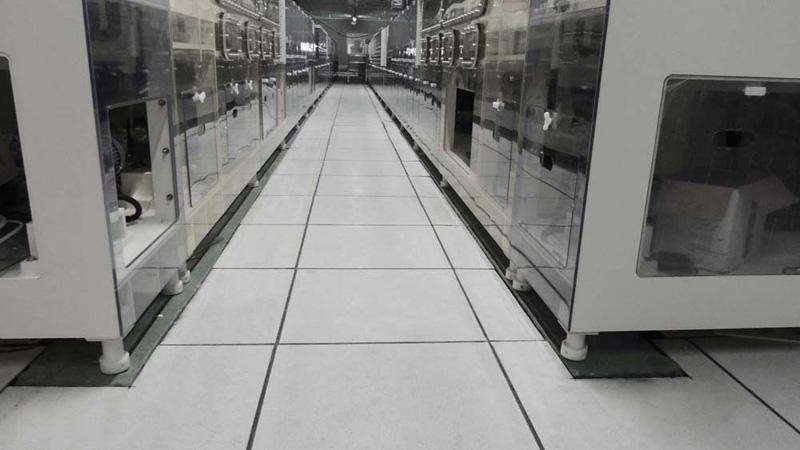4 Reasons You Should Not Specify A Floor Based on Conductive or Dissipative
What is Conductive Flooring?
Conductive Flooring is defined by electrical resistance which is the ability to resist, or stop, the flow of electricity. A conductive flooring means the flooring has an electrical resistant to ground from 1 x 104 Ω to 1 x 106 Ω
What is Dissipative Flooring?
Dissipative Flooring is defined by electrical resistance which is the ability to resist, or stop, the flow of electricity. A dissipative flooring means the flooring has an electrical resistant to ground from 1 x 106 Ω to 1 x 109 Ω
As the development of technology, more and more places will need ESD flooring.
We often here the question: Should I specify a conductive or dissipative flooring?
The answer is neither; it is a mistake to specify a floor that is conductive or dissipative without specifying metrics. Overly conductive floors could cause a potential safety risk, while some dissipative floors could transport charges too slowly to prevent static build up.
In this article, we will talk about 4 reasons why you should not specify a floor based on conductive or dissipative.
It’s an in-depth article that takes 20 minutes to read.
Navigation, click to jump to the section you want to read
4 Reasons You Should Not Specify A Floor Based on Conductive or Dissipative
1) Neither conductive nor dissipative flooring materials are universally preferred.
In some places, the conductive flooring is better than dissipative flooring, while in other places, the dissipative flooring is better.
For example, conductive vinyl flooring has more conductive veins than dissipative vinyl flooring, and the veins are placed closer together. Where there is a place need faster electrostatic discharge, then the conductive flooring is better. While static dissipative flooring might flow the electronics too slow to discharge fully.
While in a place electricity build up slowly, then we will need dissipative flooring, in this case we can slow the flow of electricity at a more controlled rate. A conductive flooring here might cause body safety to human.


2) Conductivity can change when environment change.
The resistivity of flooring cannot change, but electrical resistance cannot change when manufacturing, maintenance and environment change. Especially when temperature and humidity change.
When the air relative humidity is high, condensation or a layer of water film will appear on the surface of the insulator, resulting in the decrease of the surface insulation resistance and the increase of the surface leakage current. In addition, condensation and water film may also lead to the distortion of electric field on the surface of conductor and insulator, and the distribution of electric field is more uneven, resulting in corona
The higher the voltage level, the greater the influence of humidity on it!
For most conductors, the higher the temperature, the greater the resistance, such as metal; For a few conductors, the higher the temperature, the lower the resistance, such as carbon
You may start with a floor that’s conductive or dissipative, and find out later that the electrical resistance changed after the application environmental change.
Basing specifications on metrics: testing the resistance of the material in the prepurchase phase, then testing post installation in the environment, will ensure that the floor meets required metrics and rule out potential fluctuations base on environmental conditions.


3) Using a less conductive adhesive can cause electrical resistance to appear higher
Using an adhesive that’s less conductive than the surface of the flooring material will raise the RTG (resistance to ground) and system resistance of the floor. That’s because system resistance measures the entire system – surface and other layers of the flooring material, footwear, and adhesive.
If a flooring material measures, say, 2.5 x 104 and the underlying adhesive measures 1.0 x 108, the system resistance would likely read in the static dissipative range (> 1.0 X 106). The resistance of the flooring surface, however, remains unchanged. Despite artificially higher readings, the floor itself – and its surface – is still highly conductive.
This is a problem – why?
Adhesive that’s less conductive than the flooring material acts as a resistive barrier. In the case above, the less conductive adhesive could mask a potentially unsafe condition. If flooring was installed in an empty room this would not be a problem. However, the moment the surface of overly conductive carpet tiles is populated with grounded equipment – such as consoles and server racks- the equipment-to-carpet contact will provide an alternate (less resistant) path to ground. This condition would render the entire floor non-compliant.
For this reason, organizations like the FAA require multiple types of resistance testing: surface resistivity, point to point resistance and resistance to ground measurements. This multi-faceted approach reveals any alternate low-resistance paths to ground that would otherwise create a non-compliant installation


4) Conductivity is only one part of the ESD flooring
Some conductive – even highly conductive – floors generate static electricity. ESD vinyl and epoxy, for instance, are made from charge-generating base materials. The floor may be conductive, but unless every person in the space wears ESD footwear (heel straps, toe straps, or ESD shoes), the floor will generate harmful static charges.
For this reason, it’s crucial to also test any/all floor/s under consideration for charge generation.
Here are acceptable measurement charge generation limits by application type:
End user applications = < 500 volts ( .5kV )
Electronics manufacturing and handling applications = < 100 volts (.1kV)
Class-0 electronics = < 20 volts (.02 kV )
Conductivity is only one part of the ESD flooring equation. The floor must also prevent static generation when people walk. Even some highly conductive floors can generate static. That’s why it’s crucial to also test for charge generation.


Conclusion:
Floors should never be specified based solely on whether they are conductive or dissipative. Flooring specifications should always be evidence based, using measured and repeatable performance metrics.
Tips: It’s important to know the metrics and test the floor -before you make your selection – to be sure any floor under consideration meets your required metrics.
This article is written by Longda Flooring (www.longdaflooring.com), a leading vinyl sheet flooring manufacturer from China.
Please contact Longda flooring for a free quote on your vinyl flooring needs. We have quick response, efficient communication, quality products, on time delivery, and competitive price.
Longda flooring
- Address: Plastic Packaging Base Xiong County Baoding City Hebei Province China
- Tax number: 130638601219032
- Bank: Xiong County Branch of China Construction Bank
- Bank account: 1300 1668 4080 5000 7204
- Phone: 0086-138 2882 1440
- WhatsAPP: 0086-138 2882 1440
- Fax: 86-312-5863390
- Email: sales@longdaflooring.com
Follow us
Copy right by Longda China
